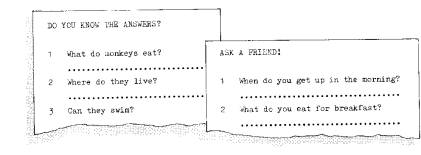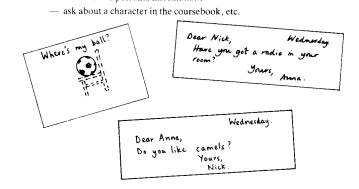
The purpose for these activities is to reinforce key items of structure
(often together with a good deal of vocabulary) There is no reason why this kind of manipulative practice need to be boring. Most workbooks provide good activities for this kind of practice, but you may need to supplement this. In any
case the suggestions below will help you to see if the workbook has left out any useful areas of activity.
a) a) Writing parallel texts
That is, the pupils have a model and have to write one or more parallel
versions.
b) b) Completing speech bubbles
The pupils now have to supply the sentences for themselves.
| c) Writing sentence sequences
This is a device for getting the pupils to write sentences using the same structure. For example, they use the days of the week to write about
themselves or perhaps a character from their coursebook. |
|
Although this involves repetition, there is always room for imagination!
| d) Compiling information
For this activity the pupils have to write some sentences which provide information, for example, about one of the characters in the coursebook or about a topic |

It often involves repetition of a structure and may be done with reference to a picture. |
| e) Writing/completing
questionnaires
For this the pupils work with questionnaires that have been prepared for them. It can be a useful way of disguising some very basic question practice. The pupils can of course use such questionnaires to question one another. |

|
c)
| Making notes
This is similar to keeping records while playing a game. Many activities involve keeping some kind of record in the form of a list. For example,
the pupils can be asked to write down, in sentence form, the differences between two pictures or the number of mistakes they can find in the picture. |
| g) Recoding personal information
Young learners like talking about writing about themselves and they will very happily write down personal data (names, age, address, family details, hobbies, etc.) or make lists of their possessions or likes or dislikes. |

|
f)
| Writing notes
Pupils write to one another in class. This is a key activity for young
learners because it gets them to write quickly. They send and answer notes. The pupils can: - ask for something ( e.g. a coloured
pencil which another pupil has in front of him) - ask for some personal information ask about a character in a coursebook, etc. |

|